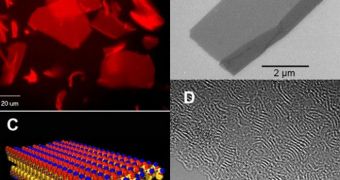A group of investigators recently managed to produce a two-layer sheet of material at the nanoscale that they say resembles a cellular wall. The substrate is made out of polymers, and the group says that it has amazingly-well defined edges. This in turn is bound to make it suitable for a wide array of potential applications in the electronics industry and in biotechnology too. The plywood-like structure is so neatly ordered that some have even compared its organization with that of proteins and crystal structures, Wired reports.
The entire sheet was synthesized to be about two-molecule, or 3-nanometer, thick, and it is also capable of floating freely inside special solutions. This means that it could be used as a universal key of sorts, for constructing electric devices at a very small scale directly from the medium. “We’re making molecular plywood – a flat piece of building material that you can build nanoscale structures with. This study will open people’s eyes and make them talk about proteins and plastics in the same sentence,” says Ronald Zuckermann, one of the experts involved in producing the new sheet.
The scientist is the coauthor of a new study detailing the findings, which appears in the April 11 issue of the respected scientific journal Nature Materials. He is based at the US Department Of Energy's (DOE) Lawrence Berkeley National Laboratory (Berkeley Lab). The new bi-layered structure is made of molecular building blocks, of which experts say are more resistant than their “all-natural” alternatives. “Ours is the largest and thinnest two-dimensional self-assembled organic crystal known,” the expert says.
“This study is a great advancement. The fact that they can produce a really large sheet on a nanometer-scale is really surprising,” explains Stanford University materials scientist Yi Cui, who was not a part of the work. The main components of the new sheet are hydrophilic and hydrophobic materials. The first class of molecules is water-loving, which mean that they seek out the chemicals, and bond with it. The second one repels water efficiently, and the research team managed to create a structure that has one type of molecules on one side and another type on the other side. The achievement was confirmed using electron microscopy.

 14 DAY TRIAL //
14 DAY TRIAL //